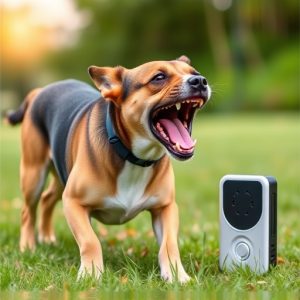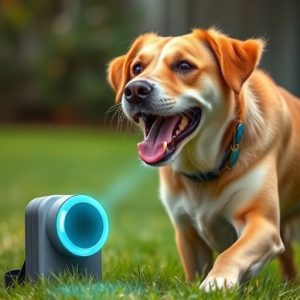Dog Repellent Devices: Safety, Science, and System Implementation
Animal control sonic repellent systems, designed to deter wildlife and domestic animals without harm…….
Animal control sonic repellent systems, designed to deter wildlife and domestic animals without harm, utilize high-frequency sound waves tailored to specific species' hearing ranges. Dog repellent devices, particularly effective against dogs, undergo stringent compliance testing to ensure safety and effectiveness for both animals and humans. This process verifies sound pressure levels, frequency response, and power output within safe ranges, maintaining the technology's humane and efficient resolution of animal intrusion issues while building consumer trust.
“Discover the future of animal control with sonic repellent systems, a non-lethal approach to keeping unwanted visitors at bay. This innovative technology uses sound waves to repel specific species, offering a safe and effective solution for both residential and commercial properties.
Our article explores the science behind these devices, their testing procedures, including crucial Dog Repellent Device Compliance Testing, and provides a guide on implementation. Learn how to navigate potential challenges and harness the power of sonic repellents for a quieter, more peaceful environment.”
- Understanding Animal Control Sonic Repellents: How Do They Work?
- Dog Repellent Device Compliance Testing: Ensuring Safety and Effectiveness
- The Science Behind Sound Waves: Targeting Specific Species
- Implementing the System: Installation, Maintenance, and Potential Challenges
Understanding Animal Control Sonic Repellents: How Do They Work?
Animal control sonic repellent systems have gained popularity as a non-lethal method to deter wildlife and domestic animals from specific areas. These devices emit high-frequency sound waves, often above the range of human hearing, which are designed to disrupt or disorient animals without causing harm. The technology is particularly effective for keeping dogs away from certain zones, such as gardens, farms, or even public spaces where their presence may be unwanted.
The effectiveness of a dog repellent device relies on its ability to emit sounds that target specific animal species’ hearing ranges. Through compliance testing, these devices are designed to meet safety standards and ensure they operate within legal parameters. This testing involves rigorous evaluations to confirm the device’s output levels, ensuring they remain below safe thresholds for human exposure while remaining effective in repelling animals.
Dog Repellent Device Compliance Testing: Ensuring Safety and Effectiveness
Dog Repellent Device Compliance Testing is a critical process that guarantees the safety and efficacy of animal control sonic repellent systems designed for dogs. These tests are pivotal in ensuring that the devices meet established standards, thereby protecting both pets and humans from potential harm. The testing protocol involves rigorous assessments of various parameters, including sound pressure level (SPL), frequency response, and power output, to confirm that the repellents emit safe sound waves within the required spectrum.
Moreover, compliance testing evaluates the device’s effectiveness in deterring dogs without causing distress or physical damage. By subjecting the repellent systems to simulated real-world scenarios, manufacturers can validate their performance claims, ensuring that the devices are not only safe but also reliable in repelling canine intruders. This thorough process is essential for building consumer trust and confidence in the technology’s ability to resolve animal intrusion issues humanely and efficiently.
The Science Behind Sound Waves: Targeting Specific Species
The Science Behind Sound Waves: Targeting Specific Species
Sound waves, an integral part of our daily lives, have been harnessed for various applications, including animal control. At its core, a sonic repellent system uses high-frequency sound waves to create a discomfort or distress in targeted animals without causing harm. These sound waves are designed to be inaudible to humans, ensuring the safety and comfort of people living near these devices. The technology leverages the unique hearing thresholds of different species, allowing for precise targeting. For instance, dogs have a broader range of hearing than humans, making them particularly sensitive to certain frequencies used in dog repellent devices.
Compliance testing plays a crucial role in verifying the effectiveness and safety of these dog repellent devices. Rigorous tests ensure that the sound waves emitted are within safe limits and specifically target the intended species without affecting others. This scientific approach not only ensures the success of animal control measures but also underscores the importance of adhering to regulatory standards, especially when it comes to protecting both animals and humans in various environments.
Implementing the System: Installation, Maintenance, and Potential Challenges
Implementing an animal control sonic repellent system involves careful planning and consideration. The first step is choosing a location for installation, ensuring it’s in compliance with local regulations and doesn’t infringe on any wildlife habitats or residential areas. Once selected, professional installers should be engaged to ensure the device is properly mounted according to manufacturer guidelines. Regular maintenance is crucial; this includes checking power sources, cleaning sensors, and updating firmware as necessary.
Potential challenges may arise from environmental factors like weather conditions affecting sensor performance or interference from other electronic devices. Additionally, wildlife adaptation can lead to changes in behavior, requiring adjustments to the system’s settings. Regular testing, including Dog Repellent Device Compliance Testing, is essential to ensure the device operates effectively and within legal parameters.
Animal control sonic repellent systems offer a non-lethal, effective solution for keeping unwanted animals at bay. By understanding how these devices work, undergoing rigorous compliance testing, and leveraging the science of sound waves to target specific species, homeowners can implement these systems with confidence. Proper installation, regular maintenance, and awareness of potential challenges ensure optimal performance, making them a practical and humane option for managing wildlife interactions.


